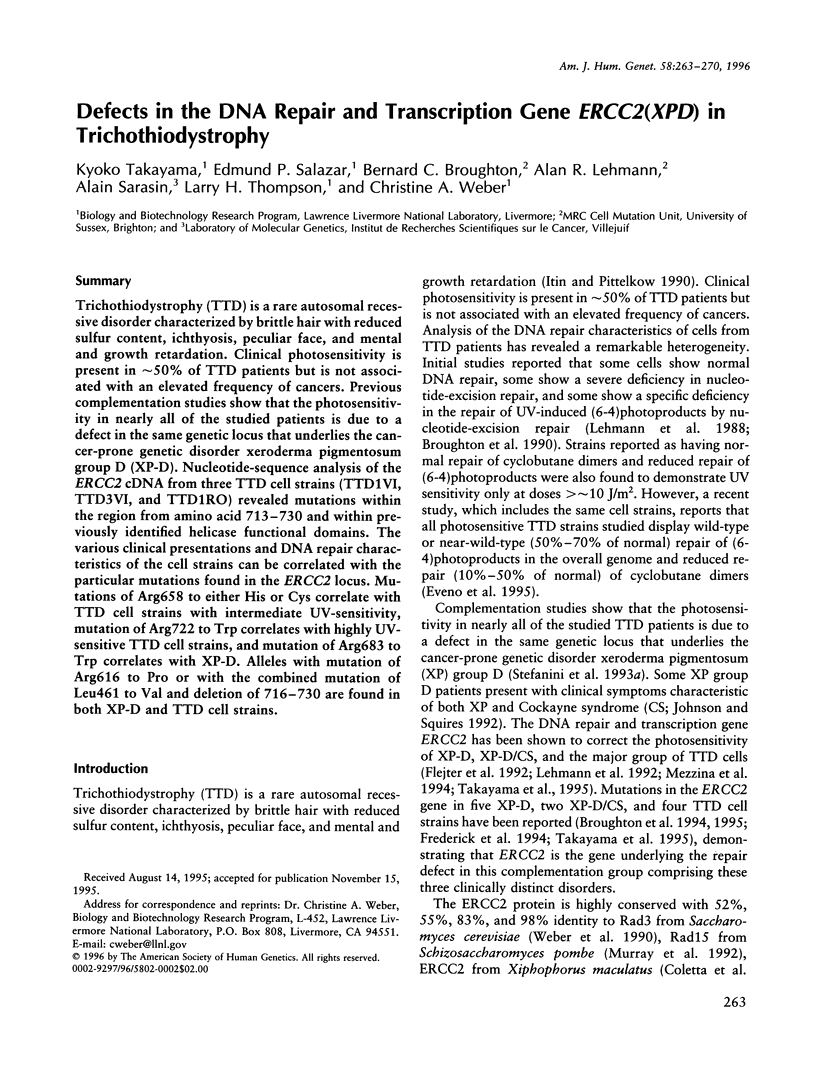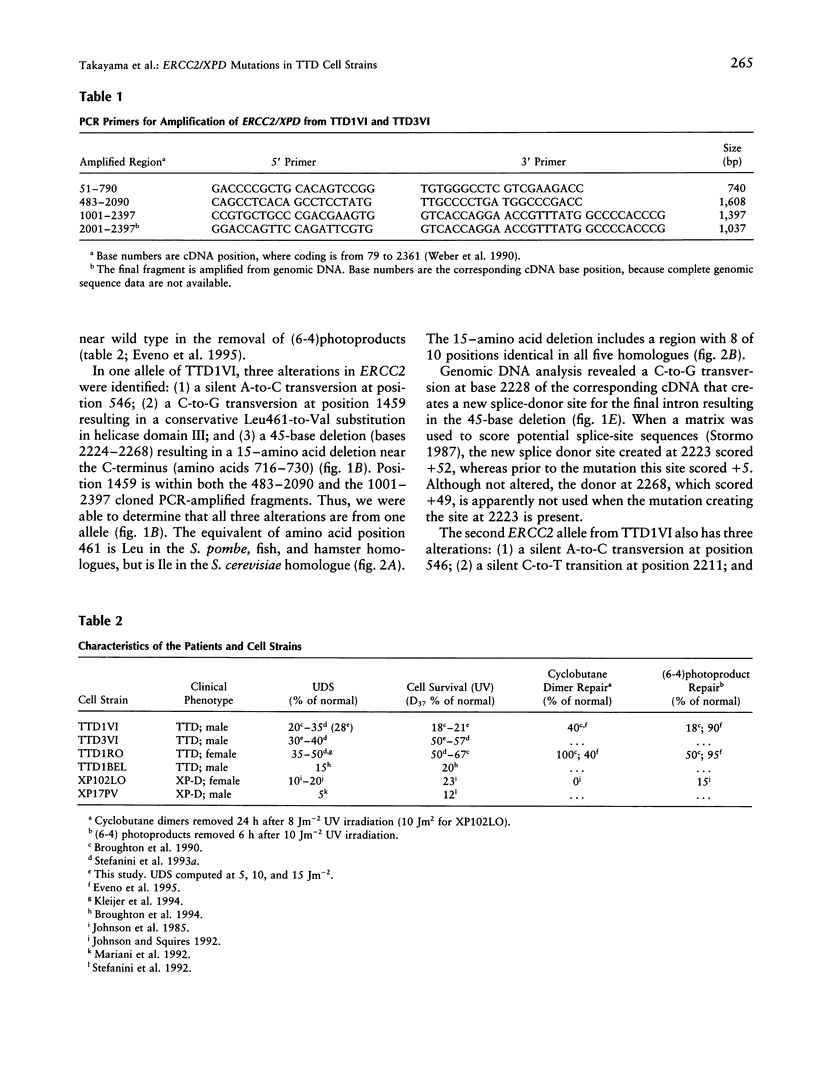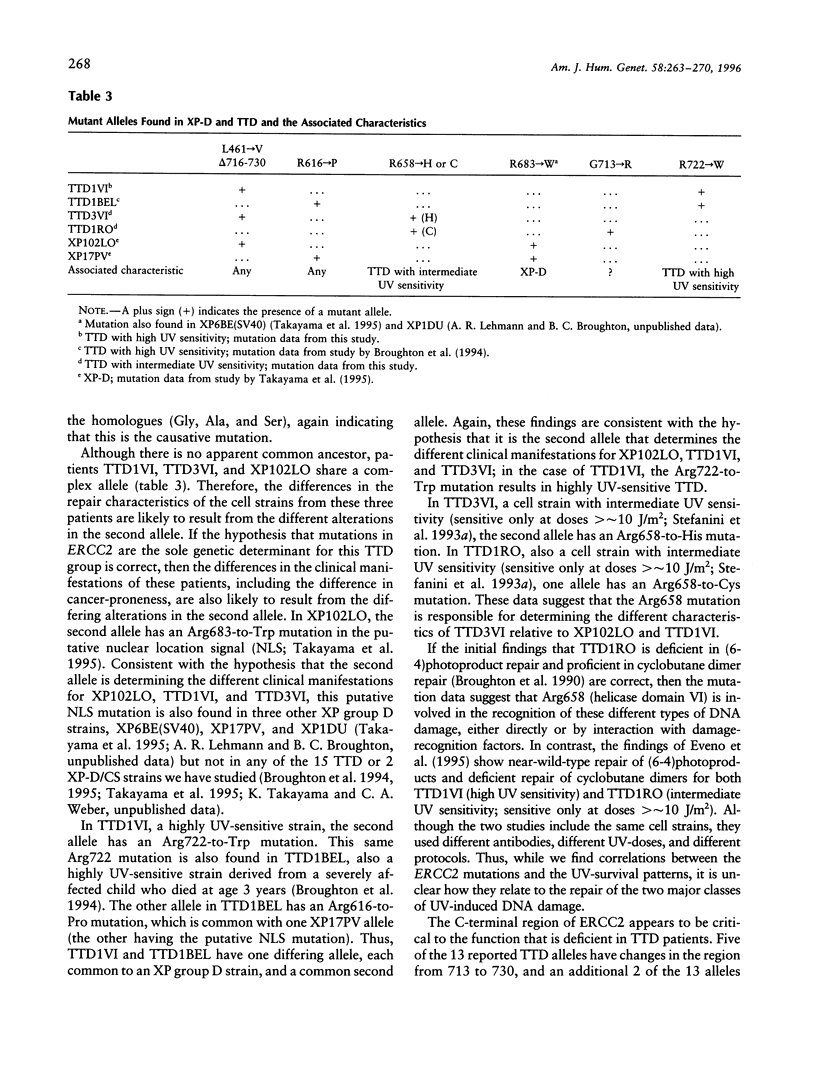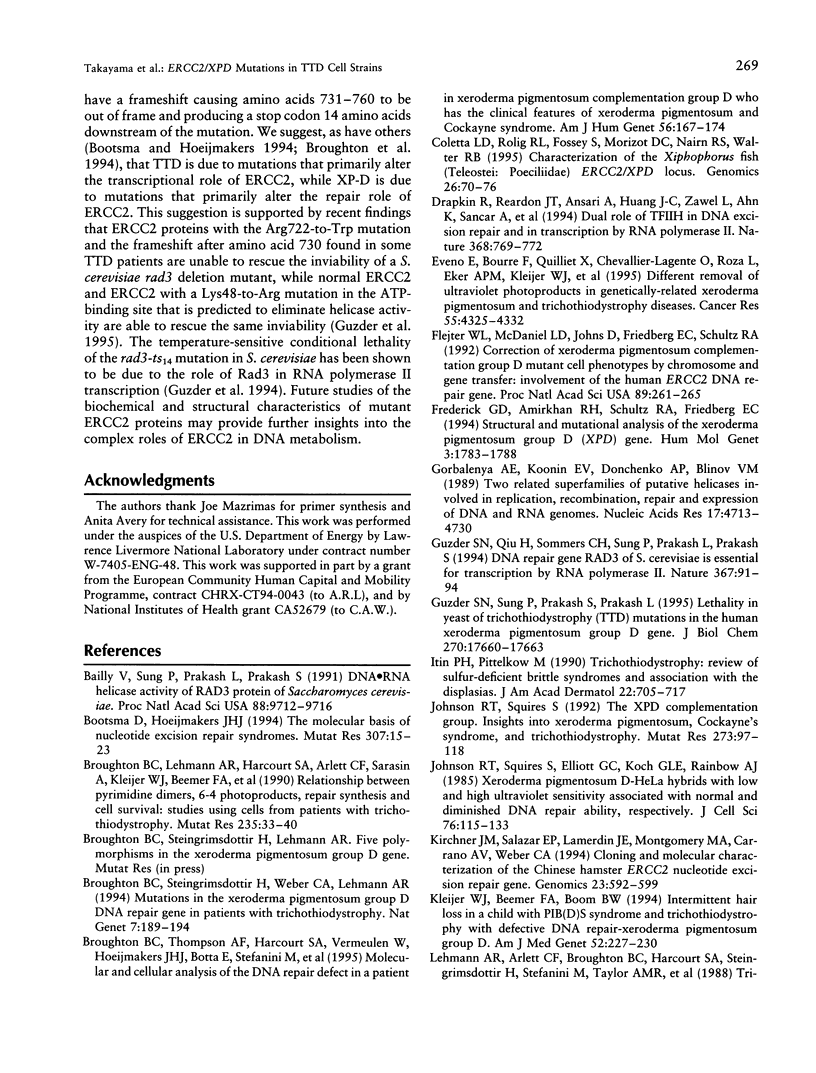Abstract
Trichothiodystrophy (TTD) is a rare autosomal recessive disorder characterized by brittle hair with reduced sulfur content, ichthyosis, peculiar face, and mental and growth retardation. Clinical photosensitivity is present in approximately 50% of TTD patients but is not associated with an elevated frequency of cancers. Previous complementation studies show that the photosensitivity in nearly all of the studied patients is due to a defect in the same genetic locus that underlies the cancer-prone genetic disorder xeroderma pigmentosum group D (XP-D). Nucleotide-sequence analysis of the ERCC2 cDNA from three TTD cell strains (TTD1V1, TTD3VI, and TTD1RO) revealed mutations within the region from amino acid 713-730 and within previously identified helicase functional domains. The various clinical presentations and DNA repair characteristics of the cell strains can be correlated with the particular mutations found in the ERCC2 locus. Mutations of Arg658 to either His or Cys correlate with TTD cell strains with intermediate UV-sensitivity, mutation of Arg722 to Trp correlates with highly UV-sensitive TTD cell strains, and mutation of Arg683 to Trp correlates with XP-D. Alleles with mutation of Arg616 to Pro or with the combined mutation of Leu461 to Val and deletion of 716-730 are found in both XP-D and TTD cell strains.
Full text
PDF







Selected References
These references are in PubMed. This may not be the complete list of references from this article.
- Bailly V., Sung P., Prakash L., Prakash S. DNA.RNA helicase activity of RAD3 protein of Saccharomyces cerevisiae. Proc Natl Acad Sci U S A. 1991 Nov 1;88(21):9712–9716. doi: 10.1073/pnas.88.21.9712. [DOI] [PMC free article] [PubMed] [Google Scholar]
- Bootsma D., Hoeijmakers J. H. The molecular basis of nucleotide excision repair syndromes. Mutat Res. 1994 May 1;307(1):15–23. doi: 10.1016/0027-5107(94)90273-9. [DOI] [PubMed] [Google Scholar]
- Broughton B. C., Lehmann A. R., Harcourt S. A., Arlett C. F., Sarasin A., Kleijer W. J., Beemer F. A., Nairn R., Mitchell D. L. Relationship between pyrimidine dimers, 6-4 photoproducts, repair synthesis and cell survival: studies using cells from patients with trichothiodystrophy. Mutat Res. 1990 Jan;235(1):33–40. doi: 10.1016/0921-8777(90)90020-6. [DOI] [PubMed] [Google Scholar]
- Broughton B. C., Steingrimsdottir H., Weber C. A., Lehmann A. R. Mutations in the xeroderma pigmentosum group D DNA repair/transcription gene in patients with trichothiodystrophy. Nat Genet. 1994 Jun;7(2):189–194. doi: 10.1038/ng0694-189. [DOI] [PubMed] [Google Scholar]
- Broughton B. C., Thompson A. F., Harcourt S. A., Vermeulen W., Hoeijmakers J. H., Botta E., Stefanini M., King M. D., Weber C. A., Cole J. Molecular and cellular analysis of the DNA repair defect in a patient in xeroderma pigmentosum complementation group D who has the clinical features of xeroderma pigmentosum and Cockayne syndrome. Am J Hum Genet. 1995 Jan;56(1):167–174. [PMC free article] [PubMed] [Google Scholar]
- Della Coletta L., Rolig R. L., Fossey S., Morizot D. C., Nairn R. S., Walter R. B. Characterization of the Xiphophorus fish (Teleostei: Poeciliidae) ERCC2/XPD locus. Genomics. 1995 Mar 1;26(1):70–76. doi: 10.1016/0888-7543(95)80084-y. [DOI] [PubMed] [Google Scholar]
- Drapkin R., Reardon J. T., Ansari A., Huang J. C., Zawel L., Ahn K., Sancar A., Reinberg D. Dual role of TFIIH in DNA excision repair and in transcription by RNA polymerase II. Nature. 1994 Apr 21;368(6473):769–772. doi: 10.1038/368769a0. [DOI] [PubMed] [Google Scholar]
- Eveno E., Bourre F., Quilliet X., Chevallier-Lagente O., Roza L., Eker A. P., Kleijer W. J., Nikaido O., Stefanini M., Hoeijmakers J. H. Different removal of ultraviolet photoproducts in genetically related xeroderma pigmentosum and trichothiodystrophy diseases. Cancer Res. 1995 Oct 1;55(19):4325–4332. [PubMed] [Google Scholar]
- Flejter W. L., McDaniel L. D., Johns D., Friedberg E. C., Schultz R. A. Correction of xeroderma pigmentosum complementation group D mutant cell phenotypes by chromosome and gene transfer: involvement of the human ERCC2 DNA repair gene. Proc Natl Acad Sci U S A. 1992 Jan 1;89(1):261–265. doi: 10.1073/pnas.89.1.261. [DOI] [PMC free article] [PubMed] [Google Scholar]
- Frederick G. D., Amirkhan R. H., Schultz R. A., Friedberg E. C. Structural and mutational analysis of the xeroderma pigmentosum group D (XPD) gene. Hum Mol Genet. 1994 Oct;3(10):1783–1788. doi: 10.1093/hmg/3.10.1783. [DOI] [PubMed] [Google Scholar]
- Gorbalenya A. E., Koonin E. V., Donchenko A. P., Blinov V. M. Two related superfamilies of putative helicases involved in replication, recombination, repair and expression of DNA and RNA genomes. Nucleic Acids Res. 1989 Jun 26;17(12):4713–4730. doi: 10.1093/nar/17.12.4713. [DOI] [PMC free article] [PubMed] [Google Scholar]
- Guzder S. N., Qiu H., Sommers C. H., Sung P., Prakash L., Prakash S. DNA repair gene RAD3 of S. cerevisiae is essential for transcription by RNA polymerase II. Nature. 1994 Jan 6;367(6458):91–94. doi: 10.1038/367091a0. [DOI] [PubMed] [Google Scholar]
- Guzder S. N., Sung P., Prakash S., Prakash L. Lethality in yeast of trichothiodystrophy (TTD) mutations in the human xeroderma pigmentosum group D gene. Implications for transcriptional defect in TTD. J Biol Chem. 1995 Jul 28;270(30):17660–17663. doi: 10.1074/jbc.270.30.17660. [DOI] [PubMed] [Google Scholar]
- Itin P. H., Pittelkow M. R. Trichothiodystrophy: review of sulfur-deficient brittle hair syndromes and association with the ectodermal dysplasias. J Am Acad Dermatol. 1990 May;22(5 Pt 1):705–717. doi: 10.1016/0190-9622(90)70096-z. [DOI] [PubMed] [Google Scholar]
- Johnson R. T., Squires S., Elliott G. C., Koch G. L., Rainbow A. J. Xeroderma pigmentosum D-HeLa hybrids with low and high ultraviolet sensitivity associated with normal and diminished DNA repair ability, respectively. J Cell Sci. 1985 Jun;76:115–133. doi: 10.1242/jcs.76.1.115. [DOI] [PubMed] [Google Scholar]
- Johnson R. T., Squires S. The XPD complementation group. Insights into xeroderma pigmentosum, Cockayne's syndrome and trichothiodystrophy. Mutat Res. 1992 Mar;273(2):97–118. doi: 10.1016/0921-8777(92)90072-b. [DOI] [PubMed] [Google Scholar]
- Kirchner J. M., Salazar E. P., Lamerdin J. E., Montgomery M. A., Carrano A. V., Weber C. A. Cloning and molecular characterization of the Chinese hamster ERCC2 nucleotide excision repair gene. Genomics. 1994 Oct;23(3):592–599. doi: 10.1006/geno.1994.1547. [DOI] [PubMed] [Google Scholar]
- Kleijer W. J., Beemer F. A., Boom B. W. Intermittent hair loss in a child with PIBI(D)S syndrome and trichothiodystrophy with defective DNA repair-xeroderma pigmentosum group D. Am J Med Genet. 1994 Aug 15;52(2):227–230. doi: 10.1002/ajmg.1320520220. [DOI] [PubMed] [Google Scholar]
- Lehmann A. R., Hoeijmakers J. H., van Zeeland A. A., Backendorf C. M., Bridges B. A., Collins A., Fuchs R. P., Margison G. P., Montesano R., Moustacchi E. Workshop on DNA repair. Mutat Res. 1992 Jan;273(1):1–28. doi: 10.1016/0921-8777(92)90046-6. [DOI] [PubMed] [Google Scholar]
- Lehmann A. R., Kirk-Bell S., Arlett C. F., Harcourt S. A., de Weerd-Kastelein E. A., Keijzer W., Hall-Smith P. Repair of ultraviolet light damage in a variety of human fibroblast cell strains. Cancer Res. 1977 Mar;37(3):904–910. [PubMed] [Google Scholar]
- Mariani E., Facchini A., Honorati M. C., Lalli E., Berardesca E., Ghetti P., Marinoni S., Nuzzo F., Astaldi Ricotti G. C., Stefanini M. Immune defects in families and patients with xeroderma pigmentosum and trichothiodystrophy. Clin Exp Immunol. 1992 Jun;88(3):376–382. doi: 10.1111/j.1365-2249.1992.tb06457.x. [DOI] [PMC free article] [PubMed] [Google Scholar]
- Mezzina M., Eveno E., Chevallier-Lagente O., Benoit A., Carreau M., Vermeulen W., Hoeijmakers J. H., Stefanini M., Lehmann A. R., Weber C. A. Correction by the ERCC2 gene of UV sensitivity and repair deficiency phenotype in a subset of trichothiodystrophy cells. Carcinogenesis. 1994 Aug;15(8):1493–1498. doi: 10.1093/carcin/15.8.1493. [DOI] [PubMed] [Google Scholar]
- Murray J. M., Doe C. L., Schenk P., Carr A. M., Lehmann A. R., Watts F. Z. Cloning and characterisation of the S. pombe rad15 gene, a homologue to the S. cerevisiae RAD3 and human ERCC2 genes. Nucleic Acids Res. 1992 Jun 11;20(11):2673–2678. doi: 10.1093/nar/20.11.2673. [DOI] [PMC free article] [PubMed] [Google Scholar]
- Prakash S., Sung P., Prakash L. DNA repair genes and proteins of Saccharomyces cerevisiae. Annu Rev Genet. 1993;27:33–70. doi: 10.1146/annurev.ge.27.120193.000341. [DOI] [PubMed] [Google Scholar]
- Sarasin A., Blanchet-Bardon C., Renault G., Lehmann A., Arlett C., Dumez Y. Prenatal diagnosis in a subset of trichothiodystrophy patients defective in DNA repair. Br J Dermatol. 1992 Nov;127(5):485–491. doi: 10.1111/j.1365-2133.1992.tb14845.x. [DOI] [PubMed] [Google Scholar]
- Schaeffer L., Moncollin V., Roy R., Staub A., Mezzina M., Sarasin A., Weeda G., Hoeijmakers J. H., Egly J. M. The ERCC2/DNA repair protein is associated with the class II BTF2/TFIIH transcription factor. EMBO J. 1994 May 15;13(10):2388–2392. doi: 10.1002/j.1460-2075.1994.tb06522.x. [DOI] [PMC free article] [PubMed] [Google Scholar]
- Schaeffer L., Roy R., Humbert S., Moncollin V., Vermeulen W., Hoeijmakers J. H., Chambon P., Egly J. M. DNA repair helicase: a component of BTF2 (TFIIH) basic transcription factor. Science. 1993 Apr 2;260(5104):58–63. doi: 10.1126/science.8465201. [DOI] [PubMed] [Google Scholar]
- Stefanini M., Giliani S., Nardo T., Marinoni S., Nazzaro V., Rizzo R., Trevisan G. DNA repair investigations in nine Italian patients affected by trichothiodystrophy. Mutat Res. 1992 Mar;273(2):119–125. doi: 10.1016/0921-8777(92)90073-c. [DOI] [PubMed] [Google Scholar]
- Stefanini M., Lagomarsini P., Giliani S., Nardo T., Botta E., Peserico A., Kleijer W. J., Lehmann A. R., Sarasin A. Genetic heterogeneity of the excision repair defect associated with trichothiodystrophy. Carcinogenesis. 1993 Jun;14(6):1101–1105. doi: 10.1093/carcin/14.6.1101. [DOI] [PubMed] [Google Scholar]
- Stefanini M., Vermeulen W., Weeda G., Giliani S., Nardo T., Mezzina M., Sarasin A., Harper J. I., Arlett C. F., Hoeijmakers J. H. A new nucleotide-excision-repair gene associated with the disorder trichothiodystrophy. Am J Hum Genet. 1993 Oct;53(4):817–821. [PMC free article] [PubMed] [Google Scholar]
- Sung P., Bailly V., Weber C., Thompson L. H., Prakash L., Prakash S. Human xeroderma pigmentosum group D gene encodes a DNA helicase. Nature. 1993 Oct 28;365(6449):852–855. doi: 10.1038/365852a0. [DOI] [PubMed] [Google Scholar]
- Takayama K., Salazar E. P., Lehmann A., Stefanini M., Thompson L. H., Weber C. A. Defects in the DNA repair and transcription gene ERCC2 in the cancer-prone disorder xeroderma pigmentosum group D. Cancer Res. 1995 Dec 1;55(23):5656–5663. [PubMed] [Google Scholar]
- Vermeulen W., van Vuuren A. J., Chipoulet M., Schaeffer L., Appeldoorn E., Weeda G., Jaspers N. G., Priestley A., Arlett C. F., Lehmann A. R. Three unusual repair deficiencies associated with transcription factor BTF2(TFIIH): evidence for the existence of a transcription syndrome. Cold Spring Harb Symp Quant Biol. 1994;59:317–329. doi: 10.1101/sqb.1994.059.01.036. [DOI] [PubMed] [Google Scholar]
- Weber C. A., Salazar E. P., Stewart S. A., Thompson L. H. Molecular cloning and biological characterization of a human gene, ERCC2, that corrects the nucleotide excision repair defect in CHO UV5 cells. Mol Cell Biol. 1988 Mar;8(3):1137–1146. doi: 10.1128/mcb.8.3.1137. [DOI] [PMC free article] [PubMed] [Google Scholar]


